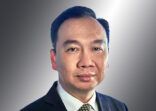“ETFs are straightforward, low-cost, transparent, liquid and flexible, allowing investors to use them as part of their long-term asset allocation strategy or to trade intra-day,” James Ross, chairman of global SPDR business at State Street Global Advisors (SSGA) told FSA in an interview.
Ross was visiting Hong Kong from Boston to celebrate the 20th anniversary of the launch of SSGA’s TraHK or Tracker Fund of Hong Kong, the first physical exchanged-traded fund in Asia ex-Japan.
In the past two decades, the tracker fund — which follows the benchmark Hang Seng index of leading Hong Kong stocks — has grown its AUM two-and-a-half times to around HK$83bn ($10.7bn), putting it among the top ten largest ETFs in the region, FE data shows.
SSGA, which competes with Blackrock and Vanguard in the passive fund market, offers 254 ETFs worldwide and manages a total of $715bn in ETF assets, according to the firm.
In Ross’s experience, many investors use ETFs as a core holding and deploy active strategies for their satellite allocation to earn alpha.
“However, some structures can be more complex, for instance those incorporating leverage, and it is important for investors to understand the benchmark the product is tracking,” he said.
But, Ross doesn’t agree with concerns that the ETF market (and passive investment products in general) are becoming too large and dominant a segment of equity markets so that there a risk that the “tail wags the dog”, with trading in the ETF market determining the direction of the prices of the underlying securities and markets.
“The role of active managers is to outperform their benchmarks, so their activities should mitigate that danger through identifying price and value anomalies,” he said.
Critics have also warned that ETFs could cause market instability, inefficiency, mis-pricing, distortions, volatility and even precipitate a spiralling market meltdown during periods of market stress.
However, Ross pointed out that during his 25 years in the business, “ETFs have always offered liquidity”, including at the worst of the financial crisis in November 2008, “when we could execute trades even when the underlying stocks or bonds weren’t trading”.
ETF growing pains in Asia
Another criticism of ETFs, especially in Asia, is harder to deflect: too many of them are small, turnover is negligible and some eventually close.
“Cost structures vary for each ETF, so there is no absolute rule about what size it needs to be to justify its continued listing. However, the major retail distribution platforms in the US require evidence that an ETF is actively traded in reasonable size before they will offer it to their customers,” said Ross.
“If an ETF fails to attract investors and build sufficient size to cover its costs, then the reason usually lies in a poor distribution and marketing strategy at launch,” said Ross.
“Being first to market with a particular theme is always important too,” he added.
Ray Chan, SSGA’s head of SPDR ETF in Hong Kong pointed out that the Asia market suffers from an additional problem.
“The distribution dynamics can count against ETFs. Distributors in Asia are still largely commission driven, so they are incentivised to favour [active] funds that charge higher fees, rather than, for example, our [Hong Kong tracker ETF] which charges only 0.09%,” said Chan.
“Although institutional money managers are now also increasingly using ETFs in general, they tend to buy ETFs listed in the US or Europe, even if they have an Asia theme, because liquidity and costs tend to be more appealing,” he said.
Industry players have also complained that Hong Kong’s ETF market lacks diversity, especially in the Greater China equity space. However, asset managers have started to offer more specialised passive products to investors, providing alternatives to the glut of China equity index ETFs.
“There are no plans at the moment for SSGA to offer existing ETFs or create new ones for the Asia market, although we are constantly looking at the potential in China,” said Chan.
Instead the focus is on attracting new investors to the tracker fund.
According to Chan, the tracker fund is increasingly being used by Hong Kong employees in their investments for retirement through Mandatory Provident Fund (MPF) schemes.
Around 16% of the assets of the ETF are held through MPF schemes, and Chan said demand is also strong among private banks, especially for their discretionary portfolio management businesses.
SSGA’s three other Hong Kong-listed ETFs are the ABF Pan Asia Bond Index Fund, the SPDR FTSE Greater China Fund and the SPDR Gold Shares Fund.
Two weeks ago, SSGA successfully applied to Hong Kong’s Securities and Futures Commission for authorisation to sell 10 funds to retail investors in the territory. These include three active products that invest in European value, global defensive and global value equities. The rest are index tracking products that cover various geographies.
















